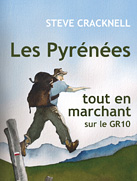I am walking in the woods, when I spot it. The size of my hand, bright red, with five prongs sticking out like a starfish, I’ve never seen anything like it before, I bend down to look closer and then reel back. It smells putrid. I prod it with a stick – not a good idea – and the smell bursts into the damp air. Looking as closely as I dare, I think I can identify the remains of insects, their bodies half liquefied in suppurating pools of black gunge. There are no leaves, no chlorophyll, so it must be some kind of fungus, I suppose.
I have no idea what it is so I take a photo and go to ask our neighbours. They have lived in the same farm all their lives, and their ancestors too..
“No, I don’t know what it is. I’ve never seen one in my life,” says the aitatxi (grand-father). “Where did you find it?” asks.
Nobody at the farm has noticed them before, though they often chase their sheep through those very same woods. I send an email to my friend Claude, who is very knowledgeable on plant life: no idea.
How come nobody knows what it is called? It is very memorable. If you see it, if you smell it, you can’t forget it.
In the end, I look on Google and quickly come across examples, but only from Australia and New Zealand. My fungus is called Clathrus archeri, devil’s fingers, or octopus stinkhorn. It is not the carnivore that I suspected. The putrefying black gunge is emitted by the plant to attract insects, which then distribute its spores.
Persistence brings results, and I eventually find some European examples. It was first seen in the Vosges in north-eastern France in 1914, unwittingly introduced by antipodean reinforcements in the First World War, on clothing or boots, perhaps. It invaded Britain during the Second World War, first being spotted in Cornwall in 1946, according to Kew Gardens.
Since then it has been conquering Europe, sneeking along the Pyrenees into Cantabria. The first reports in Spain date to 1963. In Castilian Spanish it is called estrella roja. In Euskera: izar gorri. Both mean red star.
I go back to the neighbours and ask aitatxi again: no, he doesn’t know the name. The fungus must have just arrived here for the first time.
It is a curious time-bomb. It has taken 100 years to cross France and has only just exploded in northern Navarre. Not only a time-bomb: a stink-bomb too.










Footprints on the mountains